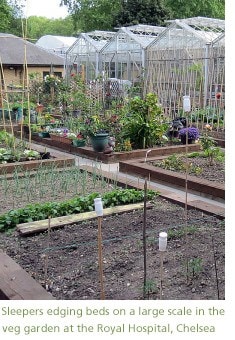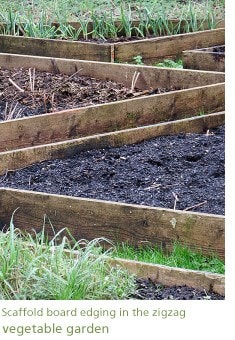Let's talk about edging
 I have been thinking a lot about the edges of things lately.
I have been thinking a lot about the edges of things lately.
Edgy, as in Nick Cage.
Cutting edge.
The Edge of Glory (the fact that I know a Lady Gaga song is one of the more unfortunate byproducts of living with not one but two teenage girls).
The Edge (as in the guitarist. My kids have heard of him too: an unfortunate byproduct of living with middle-aged mums).
Sharp edges: as in secateurs, except not mine at the moment as I have been doing too much rose pruning with them lately.
Edgways: rather like sideways, only shiftier.
Edging along unsuitably narrow bits of stone outside buildings, a talent often used in silent movies: Harold Lloyd seemed particularly fond of doing this.
Edging shears
 ‘Edge funds (OK, now I’m cheating)
Edible edging: a particularly nice thing to do to your veg beds. Curly-leaved parsley. does the trick admirably; rows of ‘Salad Bowl’ lettuces almost as well.
‘Edge funds (OK, now I’m cheating)
Edible edging: a particularly nice thing to do to your veg beds. Curly-leaved parsley. does the trick admirably; rows of ‘Salad Bowl’ lettuces almost as well.
And, since we’re straying back into kitchen garden territory again, veg bed edging. This is because I’ve been asked to turn a higgledy-piggledy veg patch into something more aesthetically pleasing in one of the gardens I look after, and that involves introducing a lot of edges.
I do like potager-style gardens. I have one in my own garden – actually, the only bit of it that’s properly finished. It has triangular beds and is a pleasingly symmetrical pattern, with a mellow stone wall at one end and a smart fence around the sides to enclose it plus a central focal point: all essential ingredients (bar the triangular beds, I suppose) for a formal vegetable garden.
In this case we’re dividing up the roughly square space into L-shaped beds around a central rectangular bed. There’s a nice deep-ish strip around the outside where there are already patches of Jerusalem artichokes, rhubarb and mint which I don’t want to disturb unless I have to; and we’re planning a self-binding gravel path a little like the ones I use myself. Easy to lay, look good and you don’t end up walking annoying little stones into the kitchen every time you come indoors.
 Which brings me to the edges. Holding the path in place – or defining the veg beds depending on your perspective – you have to have edging, and not all edges are created equal.
Which brings me to the edges. Holding the path in place – or defining the veg beds depending on your perspective – you have to have edging, and not all edges are created equal.
You can use all sorts of things to edge a bed. Many years ago I lived in a smart city garden (remembered with fondness as the first garden where I planted a vegetable: it didn’t seem particularly portentous at the time, but that row of broad beans changed my life) where the teeny-tiny beds were edged with brick, set on edge in mortar and laid at a 45° angle to make a kind of hound’s tooth top. It looked very nice but was rather expensive and a bit… well… urban for what we have in mind here.
If you want an edge which doesn’t look like an edge, a metal strip edging melts back into the ground and simply defines the difference between cultivated bit and grass, or path, or whatever goes on the other side. But – again – expensive; and more useful in grass where you’re mowing over the edges. Here we want an edge which draws lines.
In my much-thumbed copy of Joy Larkcom’s ‘Creative Vegetable Garden’ there are edges of stones (rural but you do need stones all the same size, and they look hellish to weed); hoops of beech, hazel or willow (pretty and cottage-gardeny but I’ve tried this and though beautiful it lasts only a season before it starts to break and look tatty); and a very lovely edging of discarded clay roofing tiles nailed to wooden boards which I must try some time. Slate would work equally well.
But my fall-back position on the subject of edging is without doubt wood. True, it doesn’t last forever: but five years (the average lifespan for a board) isn’t a short time, either. It looks smart yet merges seamlessly with a wider landscape; you can make it follow nearly any shape bar a curve; you can get it in most thicknesses and lengths and even I, armed with nothing more than my rickety and rather rusty old battery-operated drill, some nails and a hammer, can build gardens which look rather lovely with it, all on my own, no specialist knowledge required.
However the garden’s owner wanted sleepers: but even after we’d navigated the perils of creosote seepage from reclaimed sleepers (answer: don’t risk it and buy new sleepers instead) and wobbled a bit over the logistics of cutting something 200mm thick, the cost has come in somewhere on the eyewatering side of extortionate. To be honest I’m quite glad, as I find beds made out of sleepers to be rather over-engineered: the wood muscles into your view and takes over in a bossy, obtrusive sort of way so you can’t seem to see anything else.
Scaffold boards are option no. 2: I use these in my own zigzag vegetable garden and they’re big, thick and sturdy. And you can saw them up with an ordinary saw. They’re getting increasingly expensive as scaffolding companies cotton on to demand – the going rate is £12 for a 13ft board – but still cheaper than most wood. They have the occasional mark or splash of paint, a few dents and cracks and metal bolted around the ends, but if you mind the allotment vibe you can always get the equivalent size in new wood: it’s more expensive but neater.
And finally, good old gravel boards. I find these too flimsy for raised beds, but if you think of them more as path edging and sink them into the ground so they’re just slightly above they make subtle but definite edges which are cheap, readily available, dead easy to cut to shape and look smart but unobtrusive. This is what I made my own potager garden from, and it’s still looking good nearly three years later.
We’re still in discussion. Who knew an edge could be so… well… edgy?



 I have been thinking a lot about the
I have been thinking a lot about the  ‘Edge funds (OK, now I’m cheating)
Edible edging: a particularly nice thing to do to your veg beds. Curly-leaved
‘Edge funds (OK, now I’m cheating)
Edible edging: a particularly nice thing to do to your veg beds. Curly-leaved  Which brings me to the
Which brings me to the 